Pylon racing started on the west coast of the USA in the early 1960’s, by the mid 1960’s the pylon
race craze had travelled across the Atlantic to England. The first pylon race models were built to set
of rules called Formula 1, these models were powered by .40 size engines running on Nitromethane
based fuels, the airframes were based on full size pylon race aircraft and this gave the models a
pleasing scale like appearance.
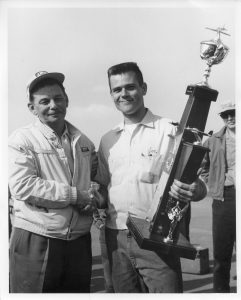
John Brodbeck of K&B engines handing Joe Martin a very impressive trophy at an early RC pylon race in California.
Pylon racing at that time was expensive and attracted a number of high profile model pilots such as
Frank Van den Burgh whose family produced Stork Margarine, Alan Mann who was carving an
enviable reputation running motor sport teams and Tony Dowdeswell who was the editor of the
RCM&E magazine at that time.
A number of modellers wanted to take part in a cheaper form of pylon racing and the outcome of
this was ½ A pylon racing. The ½ A pylon race class was based upon 2 channel non scale models
that were powered by Cox Tee Dee 049’s or 051’s. At this stage the Southampton club became
involved in both flying and the rule making process of ½ A pylon racing and Jack Anderson was at
the fore front of this process. Despite the initial attraction of ½ A pylon racing, there were problems
which mostly revolved around the temperamental Cox Tee Dee power plant.
At the end of the 1960’s another competition minded Southampton club member was dabbling in
control line speed flying, his name was Bill Beesant [sadly Bill passed away some years ago]. Bill
campaigned a very unusual flying wing in the control line speed events, this model was powered by
a Cox Tee Dee .09 and one year Bill won the control line speed event at the British Nationals.
Bill had a great interest in model engines and had setup quite a useful home workshop with a
Myford lathe and attendant equipment (as far as I know Bill was self trained in using the lathe). As
the pylon racing groups efforts got more serious, Bill offered his engineering skills and engine
tuning knowledge to further improve the performance that the group were able achieve. He also
become an unofficial team photographer at the British Nationals. Bill sold 1.5” aluminium
spinners, which pretty well all of the flyers in Club 20 used nationwide, he had 100’s of these
spinners left over from a business split with SoMoSo of Southampton, over the years Bill managed
to sell all of these spinners.
By about 1975 pylon racing was ready for another class of model. David Boddington had seen the
problems of the main pylon racing classes which were high costs and noise for the .40 size class
which by this stage had become an FAI international class and the temperamental but more cost
effective ½ A machines.
David Boddington’s idea was to base the new class around six named .19 or .20 size engines that
were economically available, matched to an airframe that was easy to build and durable. The new
class got off to a flying start and once again the Southampton club was very active in the pylon race
scene. Notably both Jack Anderson and Albert Silvey built their own design models for the
burgeoning new class. Both Jack’s and Albert’s models featured glass fibre fuselages of a very high
standard combined with foam veneered wings. Jacks model, if painted correctly, had a passing
resemblance to a Spitfire.
At the height of the Southampton club’s involvement in Club 20 racing there were over a dozen club
competitors. On the last Friday of each month the club competition secretary, who at that time was
Jack’s eldest son Kevin, would collect entries for pylon racing at Beaulieu on the Sunday morning.
Come Sunday morning the registered competitors and helpers would set up the pylons and have a
very good mornings racing.
In the spring of 1978 yet another Southampton club member committed to the construction of a
fibre glass fuselage and foam wing Club 20 model. He was Steve Jones. Steve’s model was
basically a scaled down version of the Phil Greeno designed Manneater which was a .40 size pylon
model. Steve’s fuselage was again of a high standard of construction, and he quickly went onto
produce glider fuselages for Solent Sailplanes. By the early 1980’s Steve was running the moulding
shop for Sailplanes International in Wales.
The more experienced Southampton racers ventured off and competed in National level Club 20
meetings with some degree of satisfaction and success. In 1978 and 1979 some of the more junior
racers including Ian Burridge, Clive Trowbridge and Barrie Lever entered some of these national
level race meetings but they decided they were not ready for this level of competition and would
come back and fight another day.
By about 1980 interest had waned in Club 20 pylon racing within the Southampton club, but a small
revival took place around the end of 1981 involving Tony Butterworth, who by this stage was not a
member of the Southampton club, combined with Tom Airey( from WMAC), Simon Molyneux,
Clive Trowbridge, Barrie Lever and a group of control line combat fliers from the Bournemouth
club.
This new group entered a number of Club 20 meetings prior to the Nationals in August 1982, the
group generally got on quite well but the models they entered were down on airspeed and being
able to challenge for winning meetings was some way off. The Nationals in 1982 saw both Simon
Molyneux and Barrie Lever enter Club20 pylon and Barrie also entered the .40 size FAI F3D class.
At the Nationals in the 1980’s the Southampton club entries were enthusiastically supported by
keen club members such as Alec Law, Bill Beesant and Brian Phillips. Both Bill and Brian were
also flying in novice control line stunt at the time.
The culmination of the Southampton Clubs efforts in pylon racing resulted in the sole remaining
Southampton club entries of Barrie Lever and Simon Molyneux winning the 1984 Club 20 National
championship. This team effort had also netted a 4th place in the much more complicated .40 size
FAI F3D pylon race class at the same National championship.
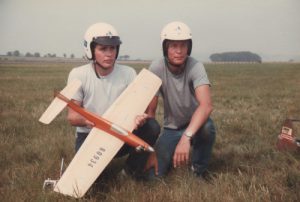
Barrie Lever and Simon Molynuex after winning the 1984 Club 20 pylon racing Nationals, OPS 20 engine in a Boddington/Toyer Tempest and Futaba Gold RC. Photo. Bill Bessant
Early in 1985 it was announced that there would be a World Championship for pylon racing. Barrie
was selected for the team to represent Great Britain. Simon Molyneux was unable to be part of the
team due to other commitments, and once again Bill Beesant became involved in the Southampton
effort.
Bill and Barrie visited the Sandown Park show in May 1985, whilst walking around Bill saw Piero
Muzio of the Italian OPS engine factory. Piero Muzio was at Sandown promoting his line of high
performance engines. Some years previously Bill had meet Piero Muzio, and Bill quickly seized
upon this chance meeting and spoke with the boss of the OPS engine factory on Barrie’s behalf.
This meeting and subsequent discussions secured full OPS factory backing for Barrie in pylon
racing into the early 1990’s. Bill also helped greatly in the manufacture of the transport box for
Barrie’s models to be transported to the World Championship in the USA.
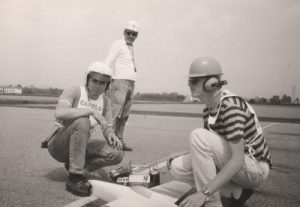
Barrie Lever preparing for a flight in the 1989 OPS trophy in Milan. The home designed model is powered by a tuned OPS 40 and the RC system is a Futaba 9VAP.
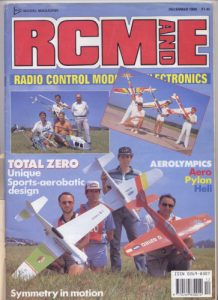
UK pylon racing team at the 1989 World Championships in Virginia Beach USA.
The rest of the 1980’s were very successful for the Barrie Lever/Simon Molyneux combination, a
number more National Championships were won and the models from Southampton built by Simon
and Barrie became the trend setters in construction and innovation especially in the Club 20 class.
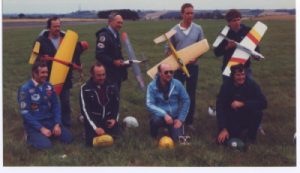
Finalists for the 1987 Nationals Club 20 pylon race final, all models are OPS 20 powered, Simon Molyneux and Barrie Lever (SMAC members) are standing in the back row 3rd and 4th right.
